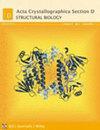Outline of Crystallography for Biologists. By David Blow. Oxford University Press, 2002. Price GBP 25 (paperback). ISBN-0-19-851051-9.
IF 2.2
4区 生物学
Acta Crystallographica Section D: Biological Crystallography
Pub Date : 2003-05-01
DOI:10.1107/S0907444903006735
引用次数: 2
Abstract
Crystallographic techniques provided the original de®nition for the term Structural Biology. They are now the pre-eminent tool for determining the structures of biological molecules with masses less than 500 00 Da, and are applicable up into the low millions. Biologists not only read the papers, but also are beginning to do the experimental work, with or without a license. David Blow's new book provides a beginner's Operator's Manual for the method. Blow himself described the book as `crystallography without maths', and that describes the outer layer well. However, because the method is so inherently mathematical, he couldn't resist adding mathematical details in grey boxes. There are copious warnings to the mathematically disinclined to stay away from the equations that lurk in these boxes, but promises to those who want the detail that there are riches to be found there. Both the warnings and the promises are well placed. In the ®rst place, no apologies are made for writing the mathematics in the formal fashion that it deserves. The grey boxes are not for those who are uncomfortable with integral signs or complex exponentials. On the other hand, the great bulk of the necessary mathematics of crystallography is laid out, concisely and clearly. Concise and clear really describes the bulk of the book too. Each topic is developed from a number of simple ideas in a logical development that is easy to follow, if one pays attention. There are copious illustrations, probably an average of one per page, that amplify the text. There are classical images: von Laue's original diffraction image, Taylor and Lipson's rubber ducky with its diffraction pattern, or Harrison's 1980 diagram showing the difference between the T = 1 and T = 3 icosahedral surface lattice of a virus. Blow uses numerous examples from the literature and his students' theses to amplify points, and some ®gures come from these. Then there are many diagrams created just for this volume. The book is divided roughly in half to reveal Fundamentals ®rst, then Practice. The subject matter nicely surveys the ®eld. Images and X-rays, Crystals and symmetry, Waves, Diffraction, and Diffraction by crystals comprise the Fundamentals section. The Practice section includes Intensity measurement, Isomorphous replacement, Anomalous scattering, Molecular replacement, Density modi®cation, Electrondensity maps, Structural re®nement and Accuracy of the model. Because Blow himself played such an important role in structure solving (the Rossmann/Blow rotation and translation functions, and the Blow/Crick method for ®nding the `best' phase from isomorphous replacement), these sections of the book are especially powerful. In summary, this is a book that can be read either by a practitioner who would like some entertainment, or by a novice who might bene®t from illumination. Because the exposition is so logical, the thread can be picked up at any point and a naõ Ève reader can get value on a particular topic and not need to start from the beginning. I believe it should be on the bookshelves of every practicing biological crystallographer for either of these eventualities.生物学家晶体学大纲。作者:David Blow。牛津大学出版社,2002。价格25英镑(平装本)。isbn - 0 - 19 - 851051 - 9。
晶体学技术为结构生物学提供了最初的定义。它们现在是确定质量小于50000da的生物分子结构的卓越工具,并且适用于低至数百万的生物分子。生物学家不仅阅读论文,而且也开始做实验工作,不管有没有许可证。David Blow的新书为这种方法提供了初学者的操作手册。Blow自己将这本书描述为“没有数学的晶体学”,这很好地描述了外层。然而,由于这种方法本质上是数学的,他忍不住在灰框中添加了数学细节。对于那些不愿远离这些方框中隐藏的方程式的数学爱好者,书中有大量的警告,但对那些想要了解细节的人来说,书中却承诺那里有丰富的财富。警告和承诺都放得恰到好处。首先,不用为用它应得的正式方式编写数学而道歉。灰框不是为那些对积分符号或复指数感到不舒服的人准备的。另一方面,晶体学的大部分必要的数学都简明而清楚地列出了。简洁和清晰也确实描述了这本书的大部分内容。每个主题都是由一些简单的想法发展而来,如果你注意的话,很容易理解。书中有丰富的插图,平均每页可能有一幅,用来放大文本。有一些经典的图像:冯·劳的原始衍射图像,泰勒和利普森的橡胶鸭子及其衍射图案,或者哈里森1980年的图表,显示了病毒的T = 1和T = 3二十面体表面晶格之间的差异。Blow从文献和他的学生的论文中使用了许多例子来放大观点,一些数字来自这些。然后有许多图表创建只是为了这个卷。这本书大致分为两半,揭示基础®休息,然后实践。这个主题很好地考察了这个领域。图像和x射线、晶体和对称、波、衍射和晶体衍射构成了基础部分。实践部分包括强度测量、同构替换、异常散射、分子替换、密度修正、电子密度图、结构元素和模型的准确性。因为Blow自己在结构求解中发挥了如此重要的作用(Rossmann/Blow旋转和翻译函数,以及用于从同构替换中结束“最佳”阶段的Blow/Crick方法),本书的这些部分特别强大。总之,这本书既适合想要娱乐的从业者阅读,也适合想要从启发中获益的新手阅读。因为阐述是如此合乎逻辑,所以可以在任何时候选择线索,并且naõ Ève读者可以在特定主题上获得价值,而不需要从头开始。我相信它应该出现在每一个生物晶体学家的书架上。
本文章由计算机程序翻译,如有差异,请以英文原文为准。
求助全文
约1分钟内获得全文
求助全文
来源期刊
自引率
13.60%
发文量
0
审稿时长
3 months
期刊介绍:
Acta Crystallographica Section D welcomes the submission of articles covering any aspect of structural biology, with a particular emphasis on the structures of biological macromolecules or the methods used to determine them.
Reports on new structures of biological importance may address the smallest macromolecules to the largest complex molecular machines. These structures may have been determined using any structural biology technique including crystallography, NMR, cryoEM and/or other techniques. The key criterion is that such articles must present significant new insights into biological, chemical or medical sciences. The inclusion of complementary data that support the conclusions drawn from the structural studies (such as binding studies, mass spectrometry, enzyme assays, or analysis of mutants or other modified forms of biological macromolecule) is encouraged.
Methods articles may include new approaches to any aspect of biological structure determination or structure analysis but will only be accepted where they focus on new methods that are demonstrated to be of general applicability and importance to structural biology. Articles describing particularly difficult problems in structural biology are also welcomed, if the analysis would provide useful insights to others facing similar problems.

 求助内容:
求助内容: 应助结果提醒方式:
应助结果提醒方式:


